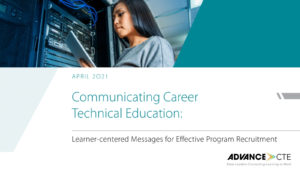The Southern Oregon Education Service District (SOESD) is taking a proactive approach to better align CTE programs with learners’ abilities and local economic needs.
The SOESD covers 13 school districts in three counties. It set out to determine if area Careeer Technical Education (CTE) programs were aligned with labor needs. It found strong alignment with some of the area’s most in-demand jobs, for example, between CTE offerings and the area’s demand for truck drivers (via transportation CTE courses) as well as for advanced manufacturing. But it found a deficit between CTE programs and the need for healthcare and construction workers.
It set out to tackle how to fill programs with the most-interested learners. Previously, some courses were full while others had enrollments as low as 30 percent.
Maximizing recruitment for CTE programs
To maximize recruitment and show learners they could excel at and enjoy careers they may have never pictured themselves in, the SOESD moved away from traditional interest-based college and career readiness solutions to YouScience Discovery, an aptitude-based solution.
Learners take the Discovery assessment — starting in the eighth grade — to uncover their work-based aptitudes, interests, and matching career pathways. The assessment revealed that learners in Oregon have more aptitude than interest in high-demand area careers.
Learners in Oregon have more aptitude than interest in high-demand area careers. Data based on anonymized internal YouScience Discovery results for 2,420 learners in Oregon from the 2021 school year.
Educators access reporting to see learners’ aptitudes- and interests- based career pathways and recruit learners into best-fit high school CTE programs.
A sample YouScience Discovery Clusters Match report that shows educators a learners’ top three career cluster matches by aptitudes and interests and that can be used to recruit learners to CTE programs.
“We meet individually with each learner, and we can say ‘here’s what you’re good at and here’s what you’re interested in,’” said Adam Randall, CTE coordinator for Henley High School. “So, when the counselors come in, they can say ‘here are all the entry-level freshman classes you should sign up for and in this order, based on your aptitudes and interests.’”
The result of using aptitudes to guide CTE enrollments resulted in some entry-level classes filling past capacity at Henley High School where Randall is based. Area enrollment overall has increased up to 160 percent.
A repeatable approach to driving CTE enrollment
The SOESD’s approach of driving CTE enrollment with aptitude-based guidance can be replicated anywhere. Discovery is available for schools nationwide. And a national student ability report points to a wide gap between learners’ aptitudes and interests that school boards and educators can leverage to ensure learners are on their best-fit educational and career pathways.
Learn more about the SOESD using YouScience Discovery, request a demo, or contact YouScience.
Kelly McNulty, Content Marketing Manager, YouScience




 Today, Advance CTE released a
Today, Advance CTE released a